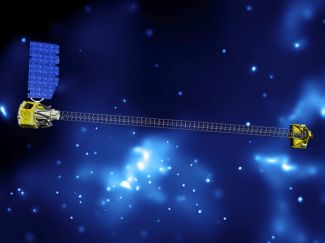NASA’s NuSTAR Captures Dazzling Images of Black Hole
By Space Coast Daily // November 13, 2013
Findings Astound Astronomers
ABOVE VIDEO: The new x-ray telescope, NuStar, is designed for locating and studying black holes. (VIDEO: CoconutScienceLab)
BREVARD COUNTY • KENNEDY SPACE CENTER, FLORIDA – NASA’s NuSTAR telescope is sending back dazzling new images of a large black hole in the center of the Milky Way Galaxy.

NuSTAR is a flying observatory equipped with X-ray vision to peer into black holes and other exotic space objects that was launched last year from a Pegasus XL rocket, carried by an Orbital Science Corporation L-1011 “Stargazer” plane taking off from the Kwajalein Atoll in the Pacific.
NuSTAR’s primary objectives include conducting a census for black holes on all scales using wide-field surveys of extragalactic fields and the galactic center; mapping radioactive material in young supernova remnants; studying the birth of the elements to understand how stars explode; observing relativistic jets found in the most extreme active galaxies and understanding what powers giant cosmic accelerators.
NASA says NuSTAR also will examine the origin of cosmic rays and the extreme physics around collapsed stars while responding to targets of opportunity including supernovae and gamma-ray bursts.

Answers Possible
Through the use of high energy X-rays, NuSTAR is offering answers to a number of long-standing questions about space.
It might be able to tell how black holes are distributed through the cosmos, how heavy elements were forged in the explosions of massive stars and what powers the most extreme active galaxies.
Observations from NuSTAR show the Milky Way black hole, called Sagittarius A, during a flare-up. The NuSTAR telescope teamed up with other observatories to observe Sagittarius A.
Those observatories were NASA’s Chandra X-ray Observatory, which receives lower-energy X-ray light; and the W.M. Keck Observatory atop Mauna Kea in Hawaii, which snaps infrared images.

NASA astronomers say that when compared to black holes at the centers of other galaxies, Sagittarius A is pretty quiet.
“We got lucky to have captured an outburst from the black hole during our observing campaign,” said Fiona Harrison, NuSTAR’s principal investigator from the California Institute of Technology in a press release.
“These data will help us better understand the gentle giant at the heart of our galaxy and why it sometimes flares up for a few hours and returns to slumber.”

Baffling Observations
It has long been known that active black holes eradicate nearby stars around them. Yet based upon observations, Sagittarius A is believed to be dormant, something that baffles astronomers.
As typical black holes consume whatever crosses their path, they usually erupt with an energy burst and expand.
The NuSTAR has detected X-rays emitted by Sagittarius A heated to about 180 million degrees Fahrenheit (100 million degrees Celsius) and originating from regions where particles are boosted close to the speed of light.
Astronomers said this data will be mixed with observations taken of Sagittarius A at other wavelengths and give them a much greater understanding of how black holes grow and consume stars and other material.
 “Astronomers have long speculated that the black hole’s snacking should produce copious hard X-rays, but NuSTAR is the first telescope with sufficient sensitivity to actually detect them,” said NuSTAR team member Chuck Hailey of Columbia University.
“Astronomers have long speculated that the black hole’s snacking should produce copious hard X-rays, but NuSTAR is the first telescope with sufficient sensitivity to actually detect them,” said NuSTAR team member Chuck Hailey of Columbia University.
NuSTAR is a Small Explorer NASA mission led by Caltech and managed by NASA’s Jet Propulsion Laboratory for NASA’s Science Mission Directorate in Washington.
The Orbital Sciences Corporation constructed the NuSTAR spacecraft.











